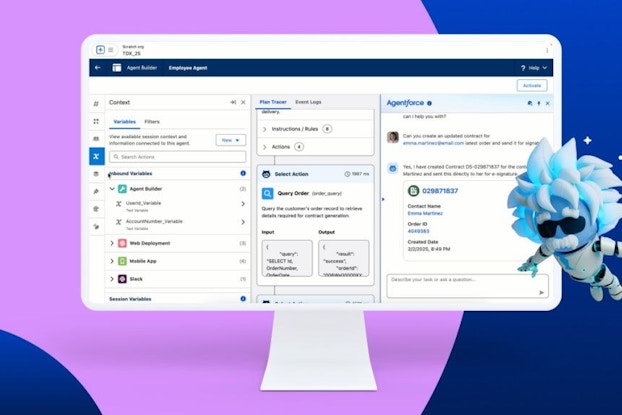
Why it matters:
- AI tools can help small businesses add functionality that previously had been more accessible to larger enterprises.
- 91% of SMBs with AI say it boosts their revenue, and 90% say it makes operations more efficient, according to Salesforce's Small & Medium Business Trends Report.
- Among the functions that AI can help automate are building a sales quote for a potential customer, scheduling employees to optimize labor costs and service levels, and sending invoice payment reminders.
Small- and medium-sized businesses (SMBs) are embracing technology tools that incorporate artificial intelligence (AI), freeing them to spend more time building relationships with their customers.
In interviews with CO—, executives from business solutions providers ADP, Intuit, and Salesforce said their SMB customers are eager to reap the benefits that AI can provide, particularly when it comes to automating routine or repetitive tasks.
"We're seeing small businesses increasingly turn to the automation and AI tools on the platform to delegate daily administrative tasks like sending estimates or invoice payment reminders, giving them the power to simply review and approve the work done for them," said Joseph Black, Director of Product Management, Accounting and Commerce, at Intuit QuickBooks. "This frees up their time to focus on other growth-driving tasks, like acquiring new customers, expanding their inventory, or building relationships with clients face-to-face."
According to research from Intuit, 12% of SMBs in the U.S. reported using AI and/or machine learning in their operations. The report concluded that AI is powering solutions for small businesses that have historically been used primarily by large corporations.
"This fast-paced AI revolution is helping smaller enterprises to scale faster and compete on a more level playing field with larger firms," the report said.
Businesses need to be very clear and transparent around their policies and procedures for using AI.Naomi Lariviere, Chief Product Owner and Vice President of Product Management, Shared Services, ADP
More time spent 'running the business'
Kris Billmaier, Executive Vice President and General Manager, Sales Cloud and Growth, at Salesforce, agrees that AI could be used to execute many of the mundane tasks that SMB operators currently handle themselves.
"People spend inordinate amounts of time doing those very basic tasks," such as building a quote for a client or potential customer or qualifying a sales lead, he said. "That now should be automated and should be done for you. People will get to spend more time actually running their businesses rather than doing the kinds of menial tasks that an agent or some assistive AI could do for them."
AI can also be used to perform large-scale tasks that might, on the surface, appear not to be worth the investment. Salesforce, for example, has tools that its clients can use to prospect for sales leads and then qualify those leads. Those functions can become much more highly automated through the use of AI, said Billmaier.

"We're super supercharging SMBs to do more with less," which will enable them to better compete with larger enterprises, said Billmaier.
According to Salesforce's recent Small & Medium Business Trends Report, 75% of SMBs are experimenting with or using AI, and 34% have fully implemented AI in their operations. In addition, 71% of SMBs are increasing their investment in AI over the next year.
SMBs are also reporting positive results from their use of AI technologies: 91% of SMBs with AI say it boosts their revenue, and 90% say it makes operations more efficient.
[Read more: Trend Forecasters on the 6 Consumer Trends Set to Impact Business in 2025]
The third stage of AI is agentic, taking business automation to new heights
Billmaier described three waves of AI that have taken place across the business landscape. Predictive AI was the first use of this type of technology, which helped companies to take actions based on past activities. That was followed relatively recently by what he called "assistive AI," which began performing some functions based on inputs, such as drafting emails or suggesting specific courses of action.
Now, however, AI has evolved into a more autonomous role, which Billmaier described as an "agentic" layer that takes assistive AI one step further by automating many routine functions, such as building a price quote for a salesperson to send to a client, for example, he said.
"This is assistive and this is autonomous, and they go hand in hand," said Billmaier.
AI embedded in SMBs' existing technology tools that streamline HR functions
A report by ADP found that some small businesses remain unsure about deploying AI and how to approach it, said Naomi Lariviere, Chief Product Owner and Vice President of Product Management, Shared Services, at ADP, which provides human resources solutions for businesses.
Small companies may be hesitant to dive into the world of AI because they feel their workforce lacks the skills needed to optimize the use of such tools, she said. Increasingly, however, solutions providers are incorporating AI into the technology tools that SMBs use, which is allowing SMBs to leverage the benefits of AI without any special technical expertise, Lariviere said.
"I think that over time, the technology will come to them," said Lariviere. "It will be included within how they work."
She cited functions such as automated scheduling to help optimize payroll costs and ensure the level of service required.
ADP has a client-facing tool called ADP Assist, which helps its clients serve their employees by answering simple questions about their benefits, for example. ADP solutions also provide insights and automated suggestions based on data analysis, such as when employees might deserve some recognition, as well as when corrective action might need to be taken, such as if an employee has been late multiple times in a given period.

"What we're trying to look for with ADP Assist is easy interventions that help businesses get to what they want very quickly," said Lariviere. "So, it's understanding them very innately and being able to understand the intention and then driving an action off of that intention."
AI designed to help SMBs make better decisions
Black of Intuit QuickBooks agreed that time-consuming tasks such as generating invoices, sending payment reminders, and creating estimates can be streamlined using AI-powered, automated platforms such as Intuit Assist for QuickBooks. These tools are even helping businesses get paid faster, he said, citing data showing that AI-generated invoice reminders created by Intuit Assist help businesses get paid 45% faster, or five days sooner, on average.
Automated AI tools can also provide actionable insights that can help SMBs respond to changes impacting their business, Black said.

"For example, Intuit Assist can proactively spot cash flow shortages in real time with suggested actions so customers can stay on top of their finances and gain better insights to make informed decisions," he said.
Intuit continues to test new features and gather feedback from its customers to better understand their experience using its platform, including its AI capabilities, Black said.
"One key learning we discovered from our early days of testing Intuit Assist is that business owners want AI tools that will make a meaningful impact on their daily operations," he said. "Small businesses often have to make quick decisions or manage several tasks at once, so overly complex or jargon-heavy AI tools that require the user to make the first move without direction aren’t going to be beneficial."
'Businesses need to be very clear and transparent around their policies and procedures for using AI'
Although the benefits of deploying AI technology are enticing, SMBs need to exercise some caution as they deploy these solutions, said Lariviere of ADP. AI tools are so readily accessible for tasks such as drafting emails or creating graphics, for example, that businesses need to have rules in place for the use of AI.
"I would say that any business owner should really have a frame of reference around what they want to use AI for," she said. "One of the things that I talk about with our clients is that if you think your employees are not using AI, you'd be surprised that they are."
"Businesses need to be very clear and transparent around their policies and procedures for using AI," she said. "You don’t want someone just going off willy-nilly and uploading your whole dataset into ChatGPT, for example."
It's also important for business teams within companies to share their experiences with each other about the lessons learned from using AI and also to learn from the successes other companies have had," Lariviere said.
CO— aims to bring you inspiration from leading respected experts. However, before making any business decision, you should consult a professional who can advise you based on your individual situation.
CO—is committed to helping you start, run and grow your small business. Learn more about the benefits of small business membership in the U.S. Chamber of Commerce, here.

Interested in a small business membership?
Find out how the U.S. Chamber of Commerce can help your company grow and thrive in today's rapidly-evolving business environment. Connect with our team to learn how a small business membership can benefit your bottom line and help you achieve your goals.







